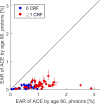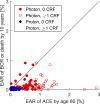Joint Estimation of Cardiac Toxicity and Recurrence Risks After Comprehensive Nodal Photon Versus Proton Therapy for Breast Cancer
- PMID: 28244411
- PMCID: PMC5625081
- DOI: 10.1016/j.ijrobp.2016.12.008
Joint Estimation of Cardiac Toxicity and Recurrence Risks After Comprehensive Nodal Photon Versus Proton Therapy for Breast Cancer
Abstract
Purpose: The study aims to perform joint estimation of the risk of recurrence caused by inadequate radiation dose coverage of lymph node targets and the risk of cardiac toxicity caused by radiation exposure to the heart. Delivered photon plans are compared with realistic proton plans, thereby providing evidence-based estimates of the heterogeneity of treatment effects in consecutive cases for the 2 radiation treatment modalities.
Methods and materials: Forty-one patients referred for postlumpectomy comprehensive nodal photon irradiation for left-sided breast cancer were included. Comparative proton plans were optimized by a spot scanning technique with single-field optimization from 2 en face beams. Cardiotoxicity risk was estimated with the model of Darby et al, and risk of recurrence following a compromise of lymph node coverage was estimated by a linear dose-response model fitted to the recurrence data from the recently published EORTC (European Organisation for Research and Treatment of Cancer) 22922/10925 and NCIC-CTG (National Cancer Institute of Canada Clinical Trials Group) MA.20 randomized controlled trials.
Results: Excess absolute risk of cardiac morbidity was small with photon therapy at an attained age of 80 years, with median values of 1.0% (range, 0.2%-2.9%) and 0.5% (range, 0.03%-1.0%) with and without cardiac risk factors, respectively, but even lower with proton therapy (0.13% [range, 0.02%-0.5%] and 0.06% [range, 0.004%-0.3%], respectively). The median estimated excess absolute risk of breast cancer recurrence after 10 years was 0.10% (range, 0.0%-0.9%) with photons and 0.02% (range, 0.0%-0.07%) with protons. The association between age of the patient and benefit from proton therapy was weak, almost non-existing (Spearman rank correlations of -0.15 and -0.30 with and without cardiac risk factors, respectively).
Conclusions: Modern photon therapy yields limited risk of cardiac toxicity in most patients, but proton therapy can reduce the predicted risk of cardiac toxicity by up to 2.9% and the risk of breast cancer recurrence by 0.9% in individual patients. Predicted benefit correlates weakly with age. Combined assessment of the risk from cardiac exposure and inadequate target coverage is desirable for rational consideration of competing photon and proton therapy plans.
Copyright © 2016. Published by Elsevier Inc.
Conflict of interest statement
Conflict of interest: IRV and MCA receive grants and educational fees from Varian Medical Systems.
Figures





Similar articles
-
Model-based approach for quantitative estimates of skin, heart, and lung toxicity risk for left-side photon and proton irradiation after breast-conserving surgery.Acta Oncol. 2017 May;56(5):730-736. doi: 10.1080/0284186X.2017.1299218. Epub 2017 Mar 10. Acta Oncol. 2017. PMID: 28281862 Clinical Trial.
-
Respiratory gating for proton beam scanning versus photon 3D-CRT for breast cancer radiotherapy.Acta Oncol. 2016 May;55(5):577-83. doi: 10.3109/0284186X.2015.1120883. Epub 2016 Mar 30. Acta Oncol. 2016. PMID: 27027913
-
Reirradiation of Head and Neck Cancers With Proton Therapy: Outcomes and Analyses.Int J Radiat Oncol Biol Phys. 2016 Sep 1;96(1):30-41. doi: 10.1016/j.ijrobp.2016.03.053. Epub 2016 Apr 13. Int J Radiat Oncol Biol Phys. 2016. PMID: 27325480
-
Potential Morbidity Reduction With Proton Radiation Therapy for Breast Cancer.Semin Radiat Oncol. 2018 Apr;28(2):138-149. doi: 10.1016/j.semradonc.2017.11.009. Semin Radiat Oncol. 2018. PMID: 29735190 Review.
-
Cardiac Side-effects From Breast Cancer Radiotherapy.Clin Oncol (R Coll Radiol). 2015 Nov;27(11):621-9. doi: 10.1016/j.clon.2015.06.007. Epub 2015 Jun 28. Clin Oncol (R Coll Radiol). 2015. PMID: 26133462 Review.
Cited by
-
Proton Therapy for Primary Breast Cancer.Breast Care (Basel). 2018 Jul;13(3):168-172. doi: 10.1159/000489893. Epub 2018 Jun 15. Breast Care (Basel). 2018. PMID: 30069176 Free PMC article. Review.
-
Is Proton Therapy a "Pro" for Breast Cancer? A Comparison of Proton vs. Non-proton Radiotherapy Using the National Cancer Database.Front Oncol. 2019 Jan 14;8:678. doi: 10.3389/fonc.2018.00678. eCollection 2018. Front Oncol. 2019. PMID: 30693271 Free PMC article.
-
Proton beam therapy causing pericarditis - a rare case of radiation induced cardiotoxicity.Cardiooncology. 2022 Apr 18;8(1):9. doi: 10.1186/s40959-022-00135-0. Cardiooncology. 2022. PMID: 35436973 Free PMC article.
-
Selection criteria for early breast cancer patients in the DBCG proton trial - The randomised phase III trial strategy.Clin Transl Radiat Oncol. 2021 Feb 4;27:126-131. doi: 10.1016/j.ctro.2021.01.012. eCollection 2021 Mar. Clin Transl Radiat Oncol. 2021. PMID: 33659716 Free PMC article.
-
Proton Therapy in Breast Cancer: A Review of Potential Approaches for Patient Selection.Technol Cancer Res Treat. 2024 Jan-Dec;23:15330338241234788. doi: 10.1177/15330338241234788. Technol Cancer Res Treat. 2024. PMID: 38389426 Free PMC article. Review.
References
-
- Poortmans PM, Collette S, Kirkove C, et al. Internal mammary and medial supraclavicular irradiation in breast cancer. N Engl J Med. 2015;373:317–27. - PubMed
-
- Thorsen LBJ, Offersen BV, Danø H, et al. DBCG-IMN: A Population-Based Cohort Study on the Effect of Internal Mammary Node Irradiation in Early Node-Positive Breast Cancer. J Clin Oncol. 2016;34:314–20. - PubMed
-
- Darby SC, Ewertz M, McGale P, et al. Risk of ischemic heart disease in women after radiotherapy for breast cancer. N Engl J Med. 2013;368:987–98. - PubMed
-
- Nissen HD, Appelt AL. Improved heart, lung and target dose with deep inspiration breath hold in a large clinical series of breast cancer patients. Radiother Oncol. 2013;106:28–32. - PubMed
Publication types
MeSH terms
Grants and funding
LinkOut - more resources
Full Text Sources
Other Literature Sources
Medical
Research Materials

